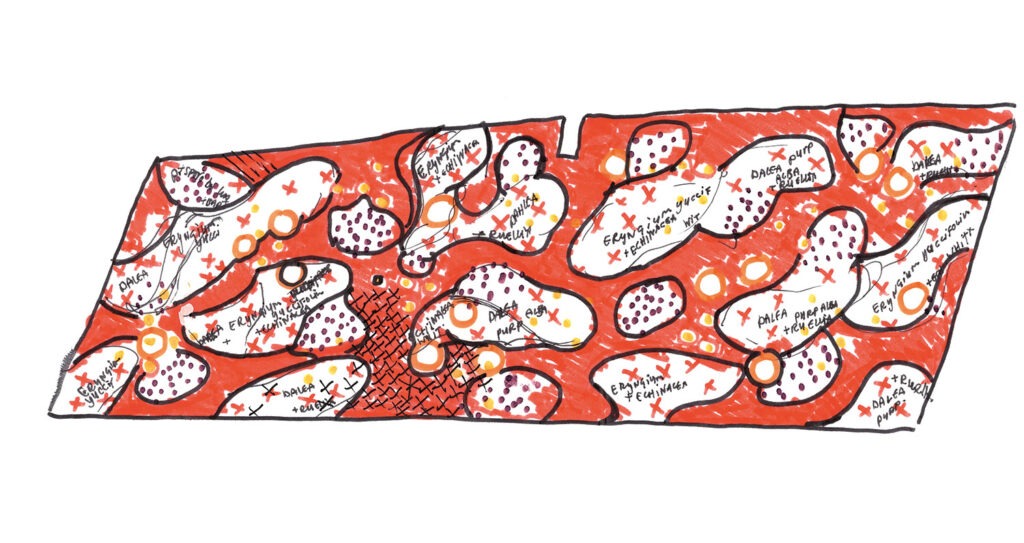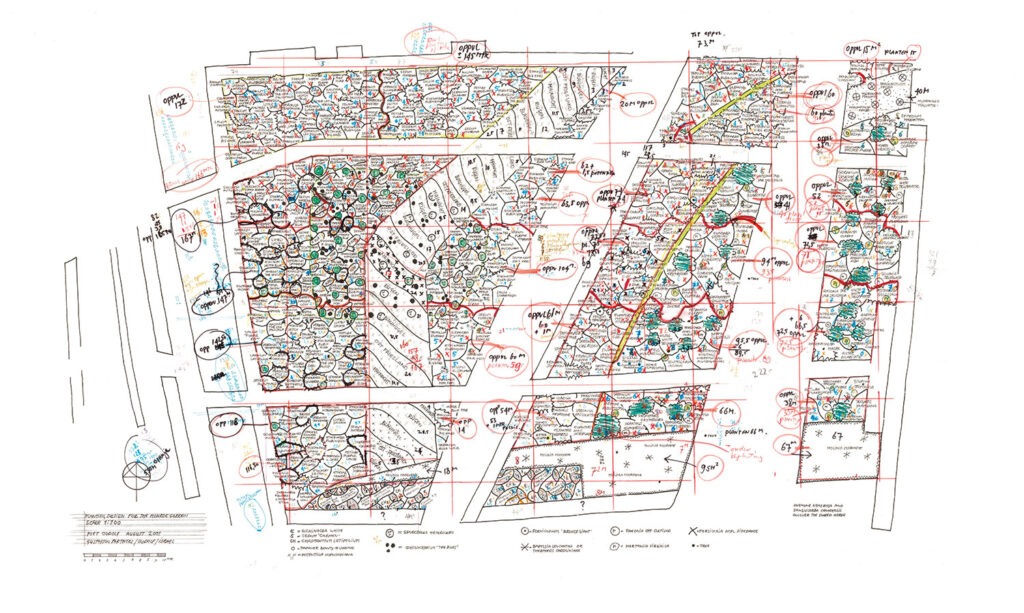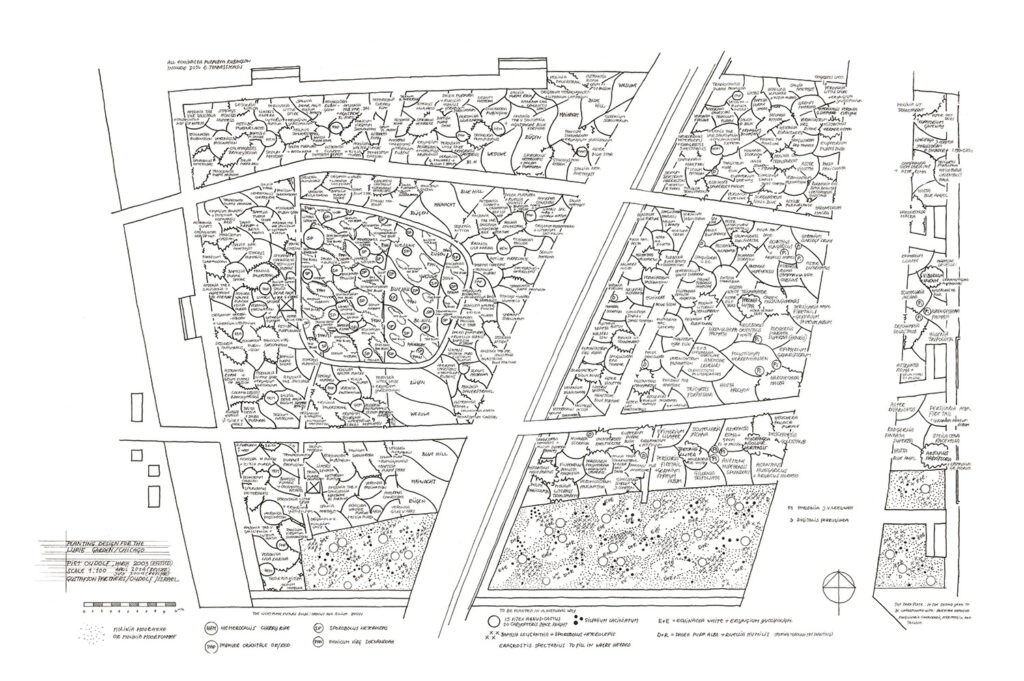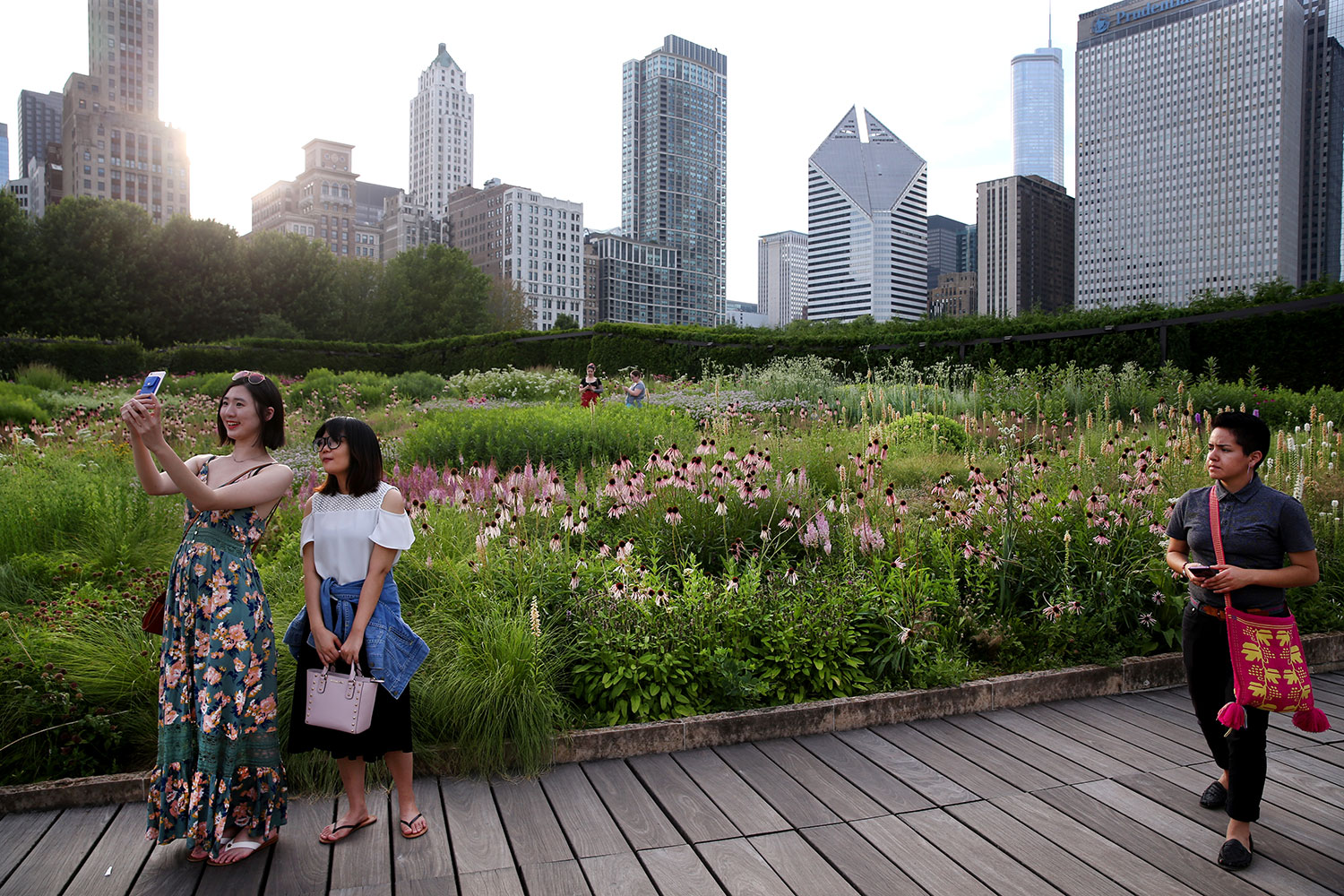The Lurie Garden opened in July 2004 and is a garden area within a larger, public space — Millennium Park — created in collaboration with landscape architects Gustafson Guthrie Nichol with the support of the Ann and Robert H. Lurie Foundation. This collaboration involved a conceptual framework being developed for the garden, not normally an aspect of Piet Oudolf’s work, and one that arguably adds nothing to the public perception of what has become an immensely popular part of the Chicago waterfront landscape, and which has also undoubtedly helped stimulate growing interest in garden-making in the region. Surrounded by a high “shoulder” hedge, a broad boardwalk (symbolizing the wooden sidewalks that once lined the city’s streets) and a narrow waterway (“the seam”) divide the site into two distinct regions of planting: the “dark plate” and the “light plate.” The dark plate is an area of open woodland, richly underplanted with shade-tolerant plants symbolizing the wild landscape that existed before the arrival of white settlers. Considerably larger, and set at a lower level, is the more open area of the light plate.
The entire site is, in fact, a roof planting over a car park; the depth of soil varies, so that there are constant slight changes in elevation. A dominant feature in early summer is the Salvia River, where four cultivars of European meadow Salvia are used to create a dramatic drift of purple-blue; Piet does not like repeating himself, but this is a copy of a feature he made for his first public park, in Enköping, Sweden. A bulb planting by Dutch designer Jacqueline van der Kloet was added a year after installation.
Around half the species used are Midwest natives. Block planting is used throughout, apart from one small area, “the meadow” — an area of intermingled planting that is more consciously naturalistic, with a higher concentration of grasses, and more intermingling of varieties. Although not described as matrix planting at the time, it was Piet’s first foray into a freer and less controlled spatial arrangement of plants.



From “The Evolution of a Plantsman” by Rosie Atkins; adapted from a chapter in the book.
Since meeting in 1998, Piet and the talented young British designer Arne Maynard had been working on plans for a Chelsea show garden sponsored by Gardens Illustrated magazine, which was launched in 1992 (I was the founding editor). Their design, called “Evolution,” was selected for the main avenue at the RHS Chelsea Flower Show in May 2000, which was an achievement in itself for two Chelsea unknowns. Piet and Maynard collaborated with Chris and Toby Marchant of Orchard Dene Nurseries, and Mark Fane and his construction team at Waterers. To our surprise, the garden won a Gold Medal and “Best in Show,” which was beyond our wildest dreams. This inevitably resulted in Piet and Maynard being inundated with requests for garden designs, and the Hummelo nursery became busier than ever, with visitors arriving by the coachload.
Around this time, Piet was asked to enter a competition to produce the planting plan for a public garden in Chicago, called the Lurie Garden. He collaborated with Kathryn Gustafson of Gustafson Guthrie Nichol, a leading firm of landscape architects based in Seattle, and in October 2000 they won the competition — Piet’s first commission in the United States. From then, until its completion in 2004, this ambitious urban renewal project, a 1 hectare (2.5 acre) roof garden on top of an underground car park and disused railway, was never far from Piet’s thoughts or his drawing board.
In September 2001, Piet was in Chicago with John Coke when the devastating attack on the Twin Towers took place. With all flights cancelled, they decided to visit nurseryman Neil Diboll, whom Piet had met years earlier, at Prairie Nursery in Wisconsin. They also met Roy Diblik at Northwind Perennial Farm, who gave them a tour of the Schulenberg Prairie in Illinois, one of the world’s oldest tall-grass prairie restorations. These meetings with kindred spirits were the start of lasting friendships.
The following year, Piet was in the U.S. again and the Battery Conservancy in New York asked Piet to produce a horticultural plan for the “Gardens of Remembrance” in the Battery, a public park named after the seventeenth century artillery batteries that were part of defenses on the southern most tip of Manhattan. This was followed by a richly planted 1.6 hectare (4 acres) grove of plane trees, now called the Battery Bosque, which opened in 2005. Anja accompanied Piet to Chicago, in 2002, where they visited the Gensburg-Markham Prairie, a vast stretch of protected land south of the city, bursting with wildlife and plant diversity, which had once been used as a resting place on cattle drives to Chicago. The unique plant communities of these prairies inspired Piet to adapt his planting plans for both the Lurie Garden and The Battery in New York. By using a rich palette of North American perennials, he was “able to achieve durability in the planting scheme and open visitors’ eyes to the beauty of their native plants.”
Excerpted from Piet Oudolf at Work© 2023 by Piet Oudolf. Reproduced by permission of Phaidon. All rights reserved.



